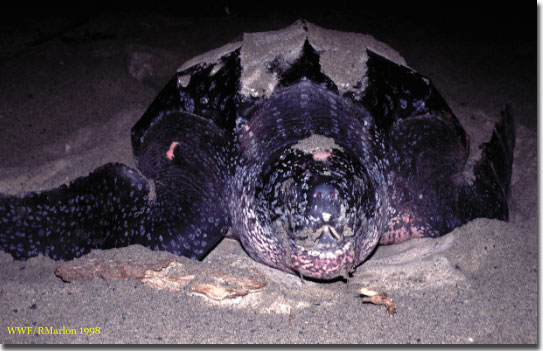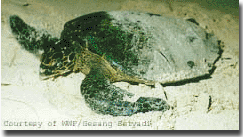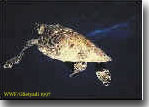MARINE TURTLE IN IRIAN JAYA
 Northern
Irian Jaya coast, on the eastern perimeter of South Pacific Ocean, is
inhabited by four marine turtle species: Leatherback (Dermochelys coriacea),
Green (Chelonia mydas), Hawksbill (Eretmochelys imbricata) and Olive
ridley (Lepidochelys olivacea). Leatherback turtle are distributed from
Waigeo Island to Yapen Island (Tomascik et.al, 1997). Since the early
1990s, current development of human settlements and logging activities
have resulted in a decline in the number leatherback nests on those
beaches, except for Jamursba Medi beach. Petocz (1987) suggested that the
other three turtle species are abundant in Cendrawasih Bay, Raja Ampat
Islands, Yapen Island and Padaido Islands.
Northern
Irian Jaya coast, on the eastern perimeter of South Pacific Ocean, is
inhabited by four marine turtle species: Leatherback (Dermochelys coriacea),
Green (Chelonia mydas), Hawksbill (Eretmochelys imbricata) and Olive
ridley (Lepidochelys olivacea). Leatherback turtle are distributed from
Waigeo Island to Yapen Island (Tomascik et.al, 1997). Since the early
1990s, current development of human settlements and logging activities
have resulted in a decline in the number leatherback nests on those
beaches, except for Jamursba Medi beach. Petocz (1987) suggested that the
other three turtle species are abundant in Cendrawasih Bay, Raja Ampat
Islands, Yapen Island and Padaido Islands.
Up to date information on these turtle populations is lacking. The WWF Indonesia - Sahul Bioregion has only collected data from certain locations: Jamursba Medi beach, Cendrawasih Bay National Park and Jayapura Bay, which provide some insight into the current situation of these turtle populations. The data are summarised below, by location (simply click the WWF logo on Map).
 Located
on Bird Head Peninsula on the northern coast of Irian Jaya (0º20'-0º22'
S and 132º25'-132º39'E, see Map), the beach is one of few remaining nesting
beaches available for the turtles, particularly leatherbacks. The beach is
unique in that it is pristine and undeveloped. Recently a company (PT.
Multi Wahana Wijaya) was granted permission from the local government to
conduct logging activity.
Located
on Bird Head Peninsula on the northern coast of Irian Jaya (0º20'-0º22'
S and 132º25'-132º39'E, see Map), the beach is one of few remaining nesting
beaches available for the turtles, particularly leatherbacks. The beach is
unique in that it is pristine and undeveloped. Recently a company (PT.
Multi Wahana Wijaya) was granted permission from the local government to
conduct logging activity.
From May through October 1999, 3,408 adult females turtle of any species were counted on this beach and 3,244 turtle (about 92.5 percent) laid the eggs (See Table 1). During peak nesting season in July 1999, fieldworkers recorded 30 new leatherback nests every night, totaling about 1,103 nests during this period (Teguh, 2000).
Table 1. Number of nests by species recorded in Jamursba-Medi beach (May to October 1999)
|
Species |
Wembrak (5.3 km) 127 days |
Baturumah (4.9 km) 131 days |
Warmamedi (5 km) 127 days |
Sub Total |
|
|
Leatherback Green Hawksbill Olive Ridley |
959 13 0 11 |
656 80 6 30 |
1368 78 7 36 |
2983 171 13 77 |
|
|
TOTAL |
3244 |
||||
Source: Teguh (2000)
Petocz (1987) assumed that the whole coast of northern Bird Head Peninsula and the north coast of Yapen Island are potential turtle nesting areas and surveys have revealed nests on all beaches in this area. However, extensive hunting and egg collection, in addition to rapid rural and urban development, have reduced nesting activities in these areas. Jamursba Medi is now one of the last harbors for these turtles lay their eggs.
Bhaskar and Bakarbessy (1984) in Bakarbessy (1999) stated that the main nesting beach was 17,9 km long and divided into three sections:
-
Wembrak beach (approx. 8,2 km) with black sand substrate.
-
Baturumah beach (approx. 5 km) with greyish white sand substrate.
-
Warmamedi beach (approx. 4,8 km) with greyish white sand substrate.
Turtle population
Table 2. Data on Leatherback Turtle Nest Recorded in Jamursba-Medi (Teguh, 2000)
|
Year |
Number |
Source |
|
1775 nests
435 nests
approx. 3000 nests
approx. 3340 nests5)
68 tracks (?) 3247 nests
3298 nests6)
3382 nests
5058 nests
4001 nests 2983 nests |
Bhaskar and Bakarbessy (1984) in Bakarbessy (1999) Bhaskar and Bakarbessy (1984) in Bakarbessy (1999) Bhaskar and Bakarbessy (1984) in Bakarbessy (1999) Betz and Welch, (1992) in National Marine Fisheries Service and U.S. Fish and Wildlife Service (1998) Stark (1993) in Teguh (2000) Bakarbessy (1993-1996) in Teguh (2000) Bakarbessy (1993-1996) in Teguh (2000) Bakarbessy (1993-1996) in Teguh (2000) Bakarbessy (1993-1996) in Teguh (2000) La Muasa (1997)
Teguh (2000) |
Notes:
1) 1985 data did not explain the monitoring date.
2) No detailed monitoring dates and number of monitoring days.
3) No detailed number by species and it is not clear whether data are include 2 olive Ridley turtle found or not.
4) No detailed number of monitoring days, but it is informed that it conducted between May to September.
5) Calculated from 25 percents of 13,360 nests.
6) Refer also to Suwelo et. al. (1994) in National Marine Fisheries Service and U.S. Fish and Wildlife Service (1998): Predicting about 2,600 female adult turtle during 1994 nesting season.
Numbers of nests appeared to be declining (See Table 2), and is probably related to increased coastal development for cultivation (coconut, cocoa and coffee), hunting, egg exploitation and trawl fishing (Petocz, 1987). The nests and hatchlings are also subject to predation by both dogs and feral pigs (Maturbongs, 1999). Other predators of hatchlings include the sea eagle (Halieathus leucogaster), crab and shark, not to mention hatchlings lost due to exhaustion while digging out the nests and swimming (Putrawidjaja, 1999).
Between 1984 to 1985, local egg exploitation was relatively intense. During the period, 4 to 5 boats visited the beach weekly and brought out 10,000-15,000 eggs per boat. This activity has been declined significantly since 1993 (Bakarbessy, 1999).
Threats
At present, the logging concessions are not restricted to the southern boundary of the nesting beach, which is gazette as limited production forest. The logging activities include lumber harvest and transportation, and the construction of a log pond and base camp. These activities potentially threaten the beach structure, due to changes to the physical environment, not to mention a potential threat of increased opportunity for poaching in the future. Logging and log transportation will likely cause erosion upstream of rivers and creeks that exit from the beach. Silting, which is likely can change the beach substrate, which are currently 78% coarse sand and 21% fine sand (Putrawidjaja, 1999). Turtle eggs require a proper substrate for development during incubation, and increased levels of silt and clay deposited on the beach can potentially reduce the hatching success of sea turtle eggs.
The use of the beach as an access for harvested lumber to log pond also has a direct impact on nesting turtles: the logs will block access to the beach by sea turtles. Human activities, both during logging and in the base camp, can disturb the turtles which are light and noise sensitive (Pritchard, 1971). High numbers of people on the beach can discourage turtles from emerging from the sea to lay nests, not to mention the possibility that the loggers will collect eggs. Chemicals used to treat the lumber have the potential to concentrate in the sand on the beach, which in turn may poison both adult turtles and developing embryos. Other wastes from the logging process, such as grease, oil, domestic wastes and sawdust potentially can pollute the water.
It is critical for the provincial government and the forestry agencies to be more proactive with respect this issue, or otherwise this unique asset will be lost. It is of utmost urgency that this beach is declared as protected area, especially for turtles. The district government of Sorong of Irian Jaya has already recommended that it receive wildlife reserve status under the Letter No. 522.5/1010, dated 8 November 1994, covering an area of 10.000 hectares. However, recommendation is not enough, and legal status must be issued. So far, the government has shown no signs of serious action or follow-up on this issue. To address the issue, WWF and Irian Jaya II Regional Nature Conservation Office held a workshop in December 1999 to gazette the beach as National Park, especially for turtle. The proposed National Park will cover an area of 465,543.45 hectares (WWF, 2000), including:
-
Jamursba-Medi beach (278,75 hectares),
-
Limited production forest in the southern boundary of the beach (74,855.50 hectares),
-
Protected forest in the other part of the area (25,595.30 hectares),
-
Northern Tamrau Mountain Nature Reserve (351,934.80 hectares) and
-
Seas (12.515,10 hectares).
[back
to top]

Turtle population
 Cendrawasih
Bay includes nesting habitat for green and hawksbill turtles. The
leatherback and olive ridley turtles are known to feed in the bay. The
islands of Nusambier, Iwari, Kuwom, Matas and Wairundi and several
mainland beaches have been recorded as turtle nesting beaches.
Cendrawasih
Bay includes nesting habitat for green and hawksbill turtles. The
leatherback and olive ridley turtles are known to feed in the bay. The
islands of Nusambier, Iwari, Kuwom, Matas and Wairundi and several
mainland beaches have been recorded as turtle nesting beaches.
Salm et.al (1982) recorded 169 turtles nested in the area (82 green, 52 hawksbill and 35 unidentified) and 88 discarded carapaces (20 green, 31 hawksbill and 17 unidentified), while other 33 turtles (21 green and 12 hawksbill) were detected in an aerial survey. Setyadi (1997) recorded turtle occurrences at several potential locations (See Table 3).
Table 3. Turtle Occurrences in Cendrawasih Bay
|
Location |
Green Turtle |
Hawksbill Turtle |
||||||||
|
Salm (1984) |
Setyadi (1997) |
Salm (1984) |
Setyadi (1997) |
|||||||
|
Nusambier Is. |
1 |
0 |
0 |
0 |
||||||
|
Iwari Is. |
0 |
0 |
0 |
1 |
||||||
|
Matas Is. |
0 |
0 |
0 |
2 |
||||||
|
Kuwom Is. |
0 |
0 |
1 |
0 |
||||||
|
Rorebo Is. |
0 |
0 |
4 |
5 |
||||||
|
Tridacna Atoll |
0 |
0 |
1 |
4 |
||||||
|
Kabuai Is. |
0 |
0 |
3 |
2 |
||||||
|
Nutabari Is. |
0 |
1 |
0 |
2 |
||||||
|
T O T A L |
1 |
1 |
9 |
16 |
||||||
Table 2 shows that there is no significant change in the number of turtle populations in the area over the years. Most of the detected habitat is composed of coral islands, such as Kuwom, Rorebo, Kabuai and Tridacna Atoll.
Threats
Turtles in Cendrawasih Bay are significantly threatened by human predation. Turtles hunting and egg exploitation, which has been practised mostly by outside fishermen for centuries, are the main threats. Putrawidjaja (1997) reported the existence of trade in meat and egg in the local fish market of Nabire. Five turtle (average weight: 5 kg) are traded daily for Rp. 6,500-10,000 (US$ 0.85-1.30) per kilo. Most of the turtles that were offered for sale were hawksbill and green turtle, and were caught in the park. Other turtles caught are directly exported to Bali, the largest turtle market in Indonesia. Eggs are also sold for Rp. 10.000 (US$ 1.30) per 10-12 eggs. The trade also occurs in other major cities around the bay including Biak, Serui and Manokwari (Putrawidjaja, 1997).
According to WWF monitoring in 1999, olive ridley turtle often were seen feeding in the bays of Jayapura. In June 1999, many hawksbill and olive ridley turtle were seen nesting on Hamadi beach (Yos Sudarso Bay, see Map), close to the Indonesian Naval Base and local fish market. This was surprising since the area is highly populated and the sago swamp occupies some of the area.Between 2-5 turtles (average weight: 5 kg) are traded daily in local fish market for of Rp. 15,000 (US$ 2) per kg. Eggs are also traded for the same price in Nabire. Local traders reported that approximately 500 eggs are traded in the market everyday.
Recommendations
Turtle populations and distribution in Irian Jaya is decreasing significantly due to predation of nests, both by natural and human predators. Turtle hunting and egg exploitation has occurred for centuries. Current development of industry and human settlement has accelerated the decrease.
Turtle exploitation, both in terms of meat and eggs, often occurs in Irian Jaya primarily due to a lack of awareness on the importance of turtle preservation, particularly among fisherman and local villagers. Management plans for turtle conservation is required to establish the protection of turtle nesting beaches and to should include the following:
-
Training and education,
-
Law enforcement, patrolling and monitoring,
-
Development of alternative local economies, e.g. seaweed and sea cucumber culture.
[back
to top]
Literature
Cited Bakarbessy,
J. 1999. Kondisi Penyu Belimbing (Dermochelys coriacea) dan Kawasan
Pantai Jamursba Medi Kecamatan Sausapor Kabupaten Sorong Propinsi Irian
Jaya (Condition of Leatherback Turtle and Jamursba Medi Beach). Research
Paper. Balai Konservasi Sumber Daya Alam Irian Jaya II, Sorong. (Bahasa
Indonesia). Maturbongs,
J.A. 1999. Marine Turtle Nesting in Sorong,Irian Jaya, Indonesia. Marine
Turtle Newsletter: Issue No. 87/January 2000. Putrawidjaja,
M. 1997. Eksploitasi Satwa Laut Langka dan Dilindungi di Irian Jaya, Studi
Kasus di Taman Nasional Teluk Cendrawasih (Exploitation of Endangered
Marine Biota, Case Study in Cendrawasih Bay National Park). Research
Paper. Cendrawasih Bay Marine National Park Project -WWF Indonesia
Programme, Nabire. (Bahasa Indonesia). ________________.
ed. 1999. Survai Keanekaragaman Hayati Pantai Peneluran Penyu Jamursba
Medi (Survey on Biodiversity of Jamursba Medi Turtle Nesting Beach).
Internal Report. WWF Indonesia - Sahul Bioregion, Jayapura. (Bahasa
Indonesia). Petocz,
R.G. 1987. Nature Conservation and Development in Irian Jaya. Pustaka
Grafiti, Jakarta. Pritchard,
P.C.H. 1971. The Leatherback or Leathery Turtle. International Union for
Conservation of Nature and Natural Resources (IUCN), Morges, Switzerland. Reksodihardjo-Lilley,
G. 1993. Laporan Kegiatan Taman Nasional Laut Teluk Cendrawasih 23 Juli-14
Agustus 1992 (Activity Report Cendrawasih Bay Marine National Park).
Internal Report. Marine Conservation Development Program - WWF Indonesia
Programme, Jakarta. (Bahasa Indonesia). Salm,
R.V.; R.G. Petocz and T. Soehartono. 1982. Survey on Coastal Area in Irian
Jaya. UNDP/FAO National Park Development Project, WWF Indonesia Programme,
Bogor. Setyadi,
G. 1997. Laporan Kegiatan Bidang Penelitian dan Monitoring Periode
Januari-Juni 1997 (Research and Monitoring Activity Report Period January
to June 1997). Cendrawasih Bay Marine National Park Project. Internal
Report. WWF Indonesia Programme, Nabire (Bahasa Indonesia). Teguh,
H. 2000. Leatherback Turtle (Dermochelys coriacea) Nesting in
Jamursba-Medi Beach, Irian Jaya. WWF Indonesia-Sahul Bioregion Sorong
Field Office, Sorong. Tomascik,
T. et. al. 1997. The Ecology of Indonesian Seas. Part II, Vol. I and VIII.
Periplus Edition Ltd. Hong Kong. WWF
Indonesia Sahul Bioregion. 2000. Prosiding Lokakarya Penetapan Status
Kawasan Konservasi Jamursba-Medi, Kecamatan Sausapor, Kabupaten Sorong,
Irian Jaya. Workshop Proceeding. WWF Indonesia-Sahul Bioregion, Jayapura (Bahasa
Indonesia).